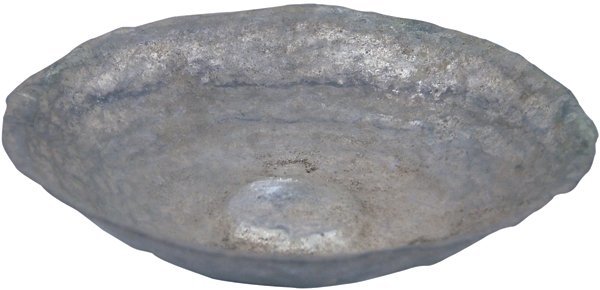220. Dish, Silver,
Diameter 9.8 cm, 10th Century.
The time has come to have a closer look at the Occident. In 1793, French revolutionaries undertook the devastation of, among others, Saint Anne’s door of the Notre Dame Cathedral in Paris that included a group of sculptures representing the kings of the Old Testament, incorrectly identified by the revolutionaries with the sovereigns of the French Ancien Régime. Picked up out of the rubble, saved in extremis, the head of King David is today part of the collection of the Metropolitan Museum of New York (Harris Brisbane Dick Fund No.38.180). As Frenchmen, proud of our patrimony, we thank the Met for having acquired the head, for keeping it, and find no legitimate grounds to clamour for its return. This head is culturally French and judicially American, legally and legitimately. Public, it became private and yet it still belongs to the heritage of humanity. Nuances in time and place between private and public, national and local, international and universal can be understood. But, as current emphasis is after all on the search for origins, we cannot resist the temptation to question what appears to all as a symbol of friendship and respect between peoples: the famous obelisk on the no less famous Place de la Concorde in the City of Lights, Paris. Epitome of harmonious legitimacy: gift of Egypt to France, the khedive (Egyptian Viceroy) having offered it to Champollion himself in anticipatory thanks for writing a book on the history of Egypt. This being said, let us ask ourselves about the presence in Paris of one of the two obelisks from Luxor. What right had the khedive, who represented an occupying power (the Ottoman Empire), Albanian by birth, tobacco merchant by profession, to dispose of a consubstantially national symbol in this way?
We can see that if we wish to question the origin of all objects of art, it is necessary in the interest of all to impose a moratorium, coupled with a strict census and a new rule defining the circulation of pieces. This is simple and fair. A last detail: our private objects, buoyed by the increasing wealth of their countries of origin, are returning to them little by little, financed by new local collectors. In the past few years, thanks to the laws of the market, all the available patrimony of Asia is returning to that continent, with the gratitude of the new owners who are conscious of the fact that the Occident served as a sanctuary for over 150 years to pieces that the circumstances of history, particularly destructive as they were, would otherwise have led to their pure and simple annihilation.
The empty cage never goes in search of its bird.
